-edible zone-
The Plinth
So, I had my beautiful Garrard sitting in the corner of my room
for a long time waiting to be resurrected. I had finally found a tone
arm in keeping with my vintage tastes and I now needed to knit the two
together. I looked at many plinth designs, not least the minimal mass
box styles which Loricraft favour. But somewhere along the line I ended
up settling for a solid mass design. I cannot say that I was a firm
believer in either approach to plinth design and of course one might
expect to go for the expert’s recommendation. I think however that the
combination of available information on forums like The Analog Dept,
Pink Fish Media, Vinyl Engine, plus other resources on how to make high
mass plinths made this design an easier choice. I am sure that lower
mass box plinth designs are relatively straight forward to make also,
but having the available templates, stories and tips, besides equal
support for either approach, it made for an attempt at a high mass
design just easier.
Using the cut out template for the 301
available in the analog dept library plus adding some requirements to
accommodate my tone arm and styling, I ended up with a plinth 610w x
606d x 108 h (mm), veneered in Santos Rosewood. I chose Birch Ply Boards
bought in a standard size of 1220mm x 606mm x 18mm. 3 standard boards of
the above measurements, each cut in half gave me x6 boards of 610mm (L)
x 606mm (W) x 18mm (T) totaling 108mm of thickness when layered. Cutting
to these dimensions was more than ample to accommodate everything and
even perhaps a little roomier than is typical. Note: Shindo Plinths are
(L) 550mm x (W) 440mm x (T) 140mm. Of course a Shindo plinth is a very
different product to the home brew version I attempted here, but I found
it useful to have a reference to a highly regarded plinth and how doing
ones own might compare in size and style. I wanted the positioning of
the motor board be to the West of the plinth top board, leaving ample
room to the East to mount my tone arm ensuring the mounting template
measurements were adhered to and leaving sufficient clearance for tone
arm balance weights. I had considered a two arm approach as I still had
a desire to try a 9" SME 3009, however I had read that such an
application required careful thought to the positioning of the tone arm
pillar in the North West corner and what the relationship was with the
motor; the consideration being that possible magnetic interference from
the motor might occur in such an application if not executed correctly.
Given this was my first plinth, I felt this time round I was better
sticking to a single arm unit.
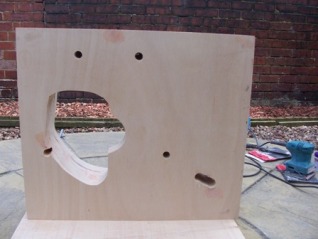
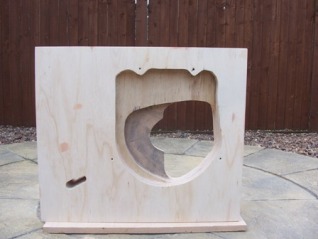
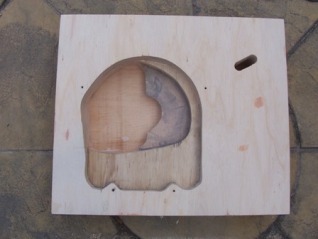
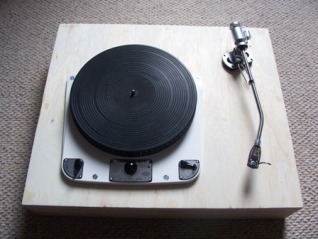
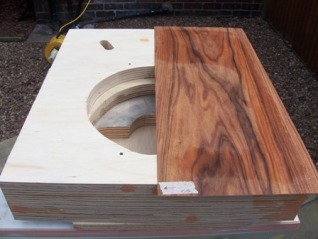
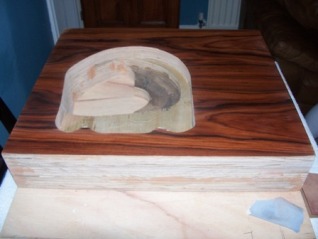
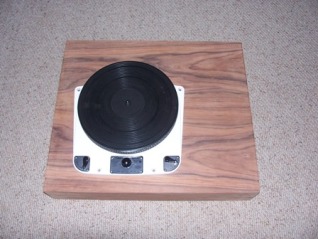
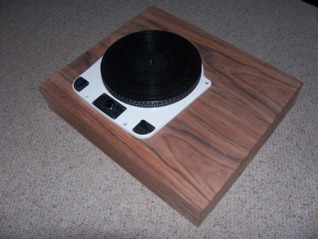
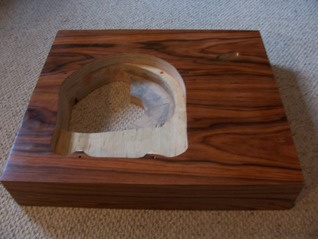
I was satisfied with the results. During the process the most difficult aspect of the build was the veneer. It is not a material or process for the faint hearted and takes some care to apply it well. It is a very fragile material, prone to splitting (so not easy to cut around corners), it is difficult to lay without trapping air and during drying has to be monitored as it can crack easily. Have no fear though, any such ‘imperfections’ are easily remedied with a bit of diligence, a sharp knife, glue and wax. The plinth can take several weeks to polish to the desired effect. French polish requires time and patience like a fine wine; polish then sand, then polish then sand and so until with age its beauty slowly reveals itself. Notes: I used M6 50mm bolts and nuts to hold the Garrard down. I placed rubber washers between the motor board and plinth top board. I used a P.I. SME spacer for the tone arm which provides sufficient height to use with the raised motor board (although I think the P.I. spacer could be adapted and made slightly taller for a better fit). I replaced all 4 rubber grommets in the SME mount plate. The SME 3012 A has a pivot to spindle mounting distance of 306mm and the MK1 a distance of 294mm or thereabouts. I therefore opted to mark a radius at 300mm exactly from the spindle and placed the SME mount plate on this radius with the line cutting through the centre. This allows me sufficient room to fine tune alignment within the bed plate tolerances.